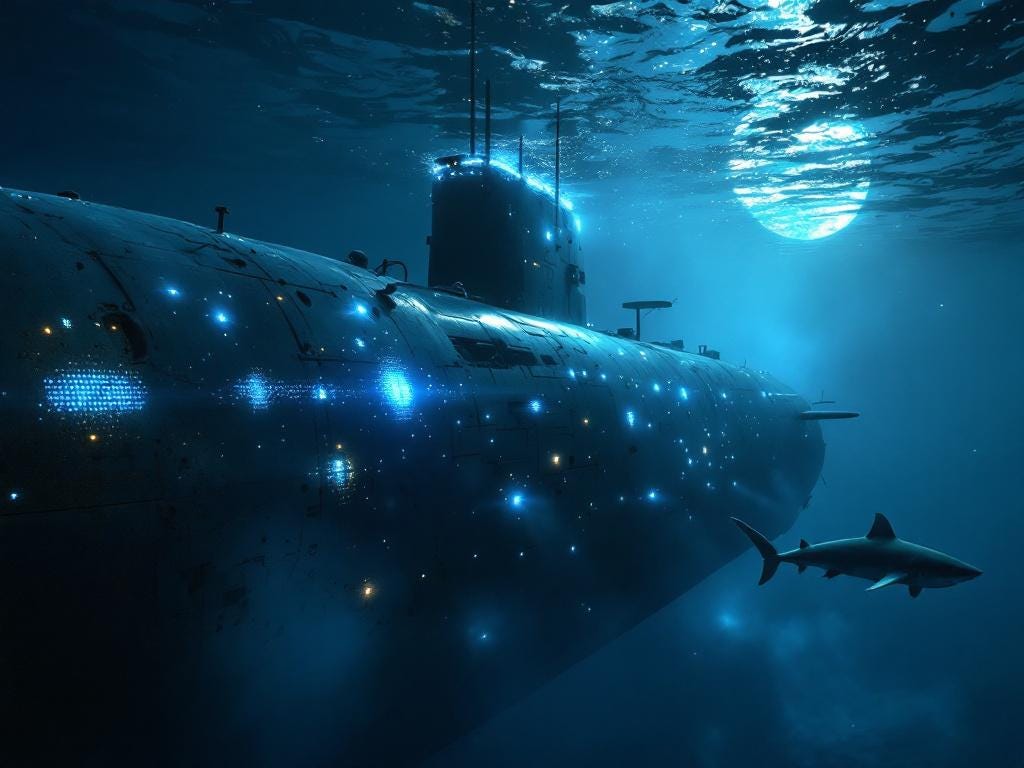ARCHIVE #007 — DARPA’S GLUE PROGRAM: THE INVISIBLE HAND THAT BINDS UNDERWATER WORLDS
📍Event
DARPA has initiated Grip Likelihood in Underwater Environments (GLUE) — a program to engineer adhesives that function with unprecedented strength, speed, and stealth beneath the waves. Not mere glue, but biologically inspired binding systems capable of adhering to any surface — steel hulls, shark skin, subsea concrete — under crushing pressure, turbulent flow, and total darkness. These materials do not just stick: they select, activate, and disappear. Funded research reveals synthetic mimics of mussel proteins, silk-based thermal triggers, and hydrogel matrices that bond faster when wet. The result? Adhesives 20x stronger than commercial equivalents, shelf-stable for years, activated by water and body heat, fully biodegradable — and designed from the outset for silent integration into military ecosystems.
This is not about repair.
It’s about attachment as strategy.
🔗 Source:
- DARPA Program Notice EA23-0104 — “Grip Likelihood in Underwater Environments (GLUE)”
- University of Pittsburgh – META-GLUE project: $259K grant for mussel-inspired hydrogels using liquid crystal elastomers and DOPA-functionalized polymers
- Tufts University – Silk-tannin composite adhesive activated at human body temperature (37°C), functional within seconds in dynamic aqueous environments
- Purdue University – Bio-adhesive research confirming increased bond strength in seawater over time, defying conventional chemistry
- Highergov & GovTribe contract databases – Multiple awarded grants under GLUE initiative
- Composites World, ACS Synthetic Biology – Peer-reviewed validation of bio-mimetic underwater adhesion mechanisms
> “We’re not building glue,” said one researcher. “We’re building programmable contact.” > Another noted: “The ocean used to be a barrier. Now it’s just another surface.”---
🔍How it fits the Control Stack
Layer 1 — Physical ⚙️🌊
Water was once the ultimate disruptor of control — scattering signals, corroding metals, blocking access. But GLUE turns the deep into a tactile domain. Surfaces are no longer passive; they become hosts. A mine can now latch silently to a ship’s keel like a remora. A sensor nestles on a whale’s dorsal fin without sutures or straps. A diver patches a submarine breach with a single strip applied mid-current — no clamps, no welds, no ascent.
Camouflage evolves from visual deception to material integration. An adhesive tag doesn’t hide — it becomes part of the organism. Attach a tracker to a great white shark using a silk-tannin patch that degrades after six months: no scarring, no detection, no trace. The animal itself becomes a mobile node in a distributed surveillance grid.
Infrastructure maintenance bypasses dry docks entirely. Repairs happen in situ, autonomously, during routine patrols. The lifetime of underwater drones extends not through better batteries — but through self-healing skins and modular component swaps held by smart glue.
The physical world is no longer rigid — it is reconfigurable on contact.
---
Layer 2 — Technological 🧪⚡
GLUE does not rely on brute-force chemistry. It leverages biological logic: molecular recognition, environmental responsiveness, energy efficiency. The adhesives are engineered to remain inert until triggered — by saltwater, pH shift, or thermal signature. Once activated, bonding occurs in seconds, often strengthening over time. Some formulations even exploit the very conditions that defeat traditional glues: motion, moisture, salinity.
These are not static materials. They are programmable interfaces between machine and environment. Imagine a drone swarm descending on a sunken vessel — each unit deploying micro-patches of GLUE to anchor sensors, reroute currents, or extract samples. Or robotic arms coated in reactive polymer sleeves that grip titanium alloys under 300 meters of ocean, then release on command via enzymatic degradation.
Crucially, production uses accessible, non-toxic feedstocks — avoiding rare catalysts or high-energy processes. This enables field synthesis. Soldiers won’t carry tubes of epoxy; they’ll stockpile dry films, powders, and patches — stable for years, deployable anywhere.
And because these adhesives degrade predictably, they leave no forensic trail. No residue. No evidence of tampering. Just clean detachment — and plausible deniability.
---
Layer 3 — Information 🕵️♂️📡
The public narrative: “Revolutionary bio-adhesives for marine conservation, wound care, and sustainable engineering.” Press releases highlight tagging endangered species, repairing coral reefs, treating combat injuries underwater.
But DARPA didn’t fund this for reef restoration.
They funded it because **permanence is power**, and **stealthy attachment is dominance**.
Every surface submerged is now a potential point of intervention. Civilian vessels. Enemy submarines. Aquaculture farms. Even living creatures. With GLUE, you don’t need to board a ship to bug it — you attach a micro-transmitter while it sleeps at port. You don’t need divers to inspect offshore platforms — send an autonomous crawler that sticks, scans, and detaches.
In war games, such capabilities redefine escalation. A nation discovers its flagship fleet subtly tagged with passive RFID markers — glued below the waterline during international exercises. No shots fired. No breach of airspace. Yet every movement tracked. Every maneuver logged.
Is it espionage? Sabotage? Environmental science?
Ambiguity is the weapon.
And GLUE thrives in the gray zone.
---
💡Conclusion
DARPA’s GLUE program is not about sticking things together.
It’s about dissolving the boundary between actor and environment.
When adhesion becomes invisible, instantaneous, and irreversible —
when the ocean itself offers no sanctuary from attachment —
then control no longer requires occupation.
It only requires contact.
And soon, nothing will slip through the cracks.
Because the cracks will already be sealed.
---
This is not an isolated incident.
It is a signal — a test.
And we are the surfaces. 🪶➡️🔗
---
Next time, they won’t just stick… they’ll whisper.
---


